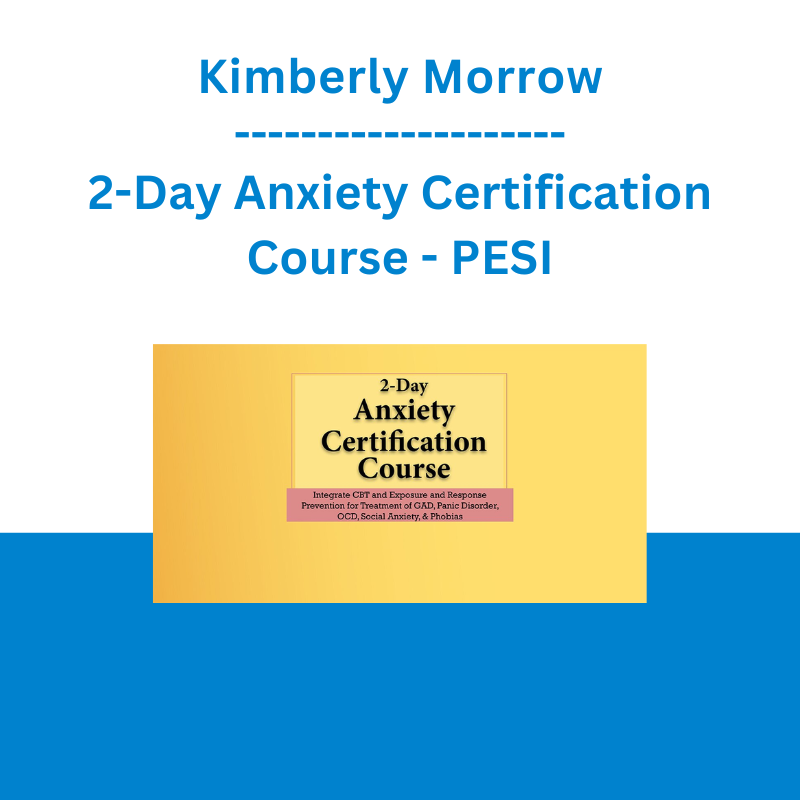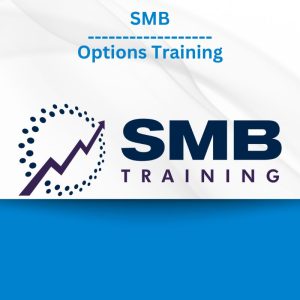*** Proof of Product ***
Exploring the Essential Features of “Kimberly Morrow – 2-Day Anxiety Certification Course: Integrate CBT and Exposure & Response Prevention for Treatment of GAD, Panic Disorder, OCD, Social Anxiety, & Phobias – PESI”
Speakers: Kimberly Morrow, LCSW | Elizabeth DuPont Spencer, MSW, LCSW-C
Format: Audio and Video
Media Type: Digital Seminar
Description
Do you feel overwhelmed by the severity of your client’s anxiety symptoms?
Does their need to seek reassurance and perform compulsions prevent them from moving forward in therapy? You are not alone if you find your clients experiencing the same symptoms after several therapy sessions, if they get stuck on the “why’s” of anxiety, or if they are unable to take meaningful action against their anxiety.
Watch award winning experts in anxiety and OCD—Kimberly Morrow, LSCW & Elizabeth DuPont Spencer, LCSW-C—for this intensive 2-Day Anxiety Certification Course to learn the gold standard of care for treating GAD, Panic Disorder, OCD, Social Anxiety, and Phobias. You’ll learn to skillfully integrate CBT and Exposure and Response Prevention (ERP) to climb over obstacles in therapy and gain confidence in your ability to treat the most symptomatic, anxious clients on your caseload.
In this intensive 2-Day Anxiety Certification Course, experts Morrow and DuPont Spencer make CBT and ERP intervention accessible and within your reach as a clinician.
You’ll start seeing real results with these cutting-edge CBT and ERP interventions, that give you:
- Ways to help clients face their triggers and change their relationship with fear
- Strategies to manage your own anxiety about treating your anxious clients
- Methods to use exposure therapy in meaningful, successful ways
- Specific strategies for Panic Disorder, phobias, OCD and social anxiety
- Packed with videos, case examples, and opportunities to practice and build skills confidently, you’ll walk away with strategies you can use the very next day!
Speakers
Kimberly Morrow, LCSWRelated seminars and products
Kimberly Morrow, LCSW, is a licensed clinical social worker in private practice in Erie, Pennsylvania. Graduating from Memphis State University with a Master’s in Psychology and the University of Wisconsin-Milwaukee with a Master’s in Social Work, Kimberly is a compassionate therapist, an anxiety expert, and a national speaker. She has been specializing in treating people with anxiety and OCD for over 25 years and teaching other professionals how to treat anxiety for over 15 years. Kimberly has given hundreds of presentations and workshops, including speaking at international conferences, providing a CBT program, speaking to schools, and training thousands of master level clinicians throughout the United States. Kimberly is a graduate of the International Obsessive Compulsive Foundation’s Behavior Therapy Institute. She is a member of the International Obsessive Compulsive Foundation and of the Anxiety and Depression Association of America, chairing several committees. She is the 2012 recipient of the Clinician Outreach Award and the 2015 Member of Distinction Award from the Anxiety and Depression Association of America. She is co-owner of AnxietyTraining.com, which provides online training and case consultation for therapists to have easy access to quality, evidenced-based training for anxiety and OCD. Kimberly is the author of Face It and Feel It: 10 Simple But Not Easy Ways to Live Well With Anxiety (Independent Distributors/Heaven-Sent Creative Concepts, 2011) and the co-author of CBT for Anxiety: A Step-by-Step Training for the Treatment of Fear, Panic, Worry, and OCD (PESI, 2018).
Speaker Disclosures:
Financial: Kimberly Morrow is the co-owner of AnxietyTraining.com and maintains a private practice. She receives royalties as an author with PESI Publishing. Kimberly Morrow receives a speaking honorarium and recording royalties from PESI, Inc. She has no relevant financial relationships with ineligible organizations.
Non-financial: Kimberly Morrow is a member of the National Association of Social Workers, the International and Obsessive Compulsive Foundation and the Anxiety and Depression Association of America.
Elizabeth DuPont Spencer, MSW, LCSW-C
Elizabeth DuPont Spencer, MSW, LCSW-C, is a licensed clinical social worker and board approved supervisor. Trained as a cognitive behavioral therapist using exposure and response prevention for anxiety disorders, obsessive compulsive disorder and depression, she has been in private practice for 25 years, working with children, adolescents and adults. Elizabeth is a member of the International Obsessive Compulsive Foundation (IOCDF), the National Association of Social Workers (NASW) and of the Anxiety and Depression Association of America (ADAA). She is a Clinical Fellow of the ADAA, and also received the 2012 Clinician Outreach Award and the 2017 Clinician of Distinction Award. Elizabeth is co-owner of AnxietyTraining.com with a mission to train clinician’s nation-wide in evidence-based treatments. A graduate of Columbia University in New York City, and the University of Maryland at Baltimore’s School of social work, she completed her clinical training at the National Institutes of Health and the Catholic University of America. She is the co-author of three books, The Anxiety Cure (2nd Ed., Wiley, 2003), The Anxiety Cure for Kids (2nd Ed., Wiley, 2014), and CBT for Anxiety: A Step-by-Step Training Manual for the Treatment of Fear, Panic, Worry, and OCD (PESI, 2018). Elizabeth works in Rockville, Maryland.
Speaker Disclosures:
Financial: Elizabeth DuPont Spencer maintains a private practice and is co-owner of AnxietyTraining.com, LLC. She receives royalties as a published author. Elizabeth DuPont Spencer receives a speaking honorarium, recording royalties and book royalties from PESI, Inc. She has no relevant financial relationships with ineligible organizations.
Non-financial: Elizabeth DuPont Spencer is a member of the Anxiety Disorders Association of America, the National Association of Social Workers, and the International Obsessive-Compulsive Foundation.
Objectives
- Demonstrate the CBT session structure with anxious clients in order to achieve positive clinical outcomes.
- Assess for and diagnose each DSM-5® anxiety disorder, including Obsessive-Compulsive Disorder, Generalized Anxiety Disorder, Social Anxiety Disorder, Separation Anxiety Disorder, PANS/PANDAS, and Panic Disorder.
- Integrate Exposure and Response Prevention (ERP) techniques to increase your client’s success.
- Utilize strategies that help family members become anxiety “coaches” for the client.
- Formulate interventions for challenging automatic negative thoughts in clients who have been diagnosed with anxiety.
- Plan when it is clinically appropriate to use extreme exposure interventions with clients.
- Demonstrate the use of interoceptive therapy for treating panic in clients.
- Analyze the purpose of utilizing paradoxical exposures when treating social anxiety.
- Apply knowledge about Generalized Anxiety Disorder to learn how to prevent fears about the future from interfering with quality of life.
- Utilize play-based exposure interventions for the treatment of anxiety in children.
- Employ Exposure and Response Prevention techniques to reduce symptoms of Obsessive-Compulsive Disorder.
- Formulate treatment termination and relapse prevention plans with clients.
Outline
- Getting Started: How to Optimize the Early CBT Sessions
Principles of CBT – Establish roles and goals
How to socialize your client to the CBT Session structure
Get your client to do homework
What not to do (reassurance, rabbit hole)
Tools for goal setting
Begin with the end in mind: Termination considerations - Assessment and Treatment Planning: Set the Stage for Successful Treatment
Diagnosis – why it’s important
Key questions to ask at intake
Assessment forms – where to find them
Teach your clients to use a notebook
Using a SUDS scale - Anxiety and the Brain: What Every Client Needs to Know
Why this is a pivotal point of treatment
Simple ways to teach clients about anxiety and the brain
The role of avoidance and safety behaviors
Medication-what is helpful and what is not - The Art of Exposure and Response Prevention (ERP)
The role of the clinician
Teach clients to ride the wave of anxiety
Create a fear hierarchy using SUD scales
How to set up an exposure
Working with resistance to exposure
What NOT to do and why - Cognitive Therapy: Change the Way Clients Think about Thinking
Empower clients to choose how to interpret their thoughts
Utilize values clarification to motivate change
Challenge distortions and core beliefs that get in the way of change
The role of mindfulness in anxiety treatment - Family Involvement: Teach Loved Ones to be a Part of the Solution
Help families learn healthier ways to talk back to anxiety
Teach how to respond without reassuring
Challenge loved ones to face their own fears - Phobias and OCD: Exposure and Response Prevention in Action
Identify OCD’s tricks
Strategies for the most common phobias (heights, spiders, small spaces and more!)
How to get comfortable with extreme exposures
– Vomit phobia, fear of harm, contamination, obsessive thoughts, sexual obsession
Identify your own obstacles to successful ERP
Get out of the office!
Using scripts
Demonstrations and practice - Panic Disorder: Interoceptive Exposure Techniques That Work
Why deep breaths aren’t enough
Practice breathing to increase CO2
Identify the fear in panic
How to induce symptoms of panic to build tolerance of discomfort
Strategies for choosing a panic behavior to replicate - Social Anxiety: Paradoxical Treatment Interventions that Get Results
Going after embarrassment
Tools to practice mindfulness during conversations
Build clients’ “I can handle it” muscle
Help clients improve insight about their fears
How to remove safety behaviors in social situations - Generalized Anxiety Disorder (GAD) and Worry: Helping Our Clients Live in the Present
Overcoming the fear that “I won’t be able to handle it”
Tools that teach clients how to handle distressing thoughts/feelings
Utilize mindfulness/living in the present
Write worry scripts, assign time for worry, chase after worry - Kids with Anxiety: Playing with Fear
Special considerations when working with children
School refusal, contamination, bad thoughts, PANS/PANDAS
Add play to your treatment plan
Strategies for age appropriate interventions
Teach kids to talk back to their fears
How to handle parent resistance/therapy interference - Termination and Relapse Prevention
Develop a client wellness plan that sticks
Help clients identify red flags
Teach clients to do ongoing exposures
Establish a plan for when to return to therapy
Risks and limitations of the research
Target Audience
- Social Workers
- Psychologists
- Counselors
- Marriage and Family Therapists
- Physicians
- Case Managers
- Addiction Counselors
- Therapists
- Other Mental Health Professionals
Reviews
Nicauris U
“Very good and knowledgeable workshop! Recommended 100%”
Emily S
“great course!”
Phyliss W
“Thank you! Good experience!!”
Please see the full list of alternative group-buy courses available here: https://lunacourse.com/shop/










 Simpler Trading - Bruce Marshall - The Options Defense Course
Simpler Trading - Bruce Marshall - The Options Defense Course